Leadership and Decision-making
VerifiedAdded on 2023/04/20
|14
|4128
|241
AI Summary
This study analyzes the leadership style and approaches of a known leader, examining their traits and relating them to relevant leadership theories. The study aims to develop an understanding of personal professional growth and leadership.
Contribute Materials
Your contribution can guide someone’s learning journey. Share your
documents today.
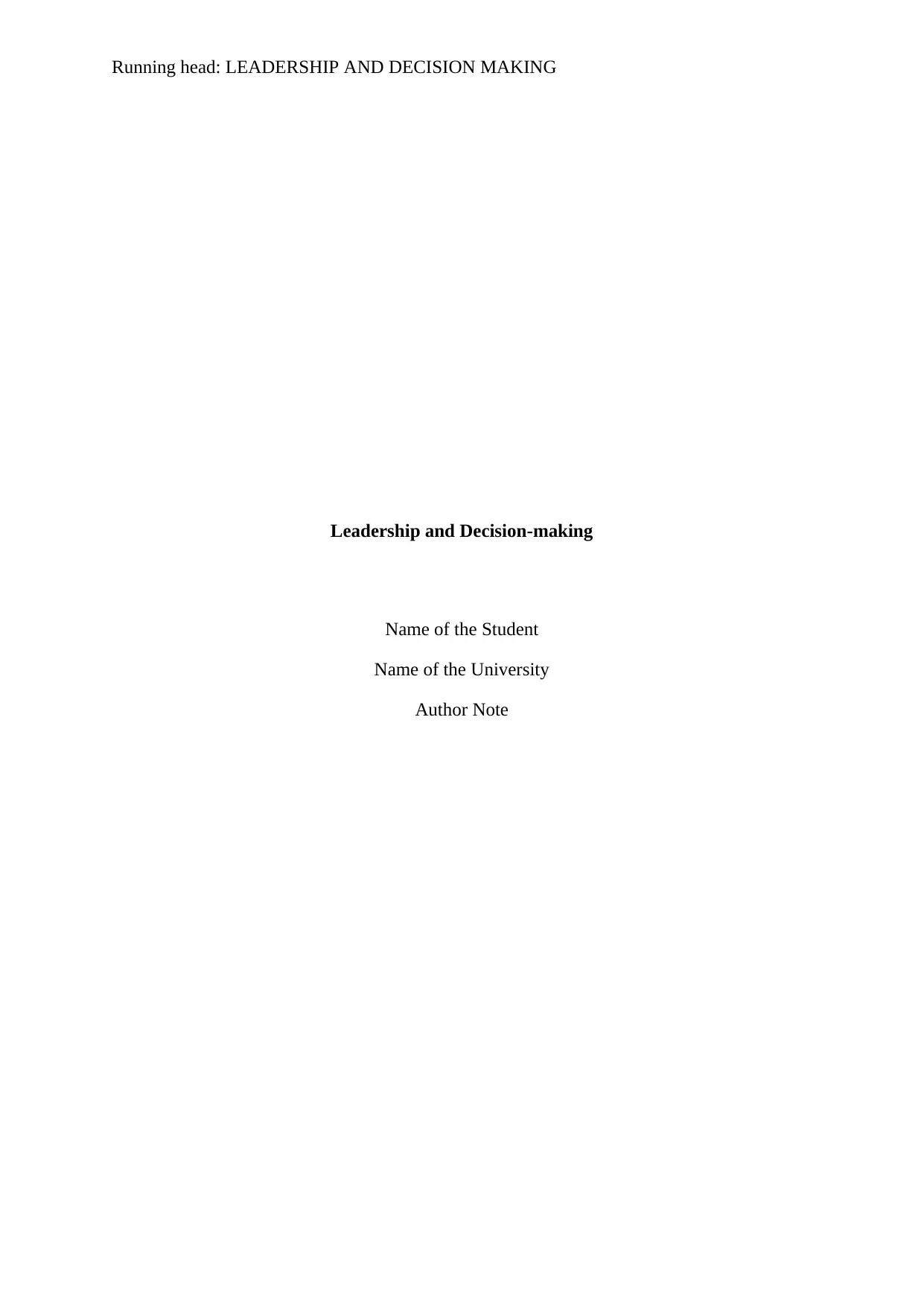
Running head: LEADERSHIP AND DECISION MAKING
Leadership and Decision-making
Name of the Student
Name of the University
Author Note
Leadership and Decision-making
Name of the Student
Name of the University
Author Note
Secure Best Marks with AI Grader
Need help grading? Try our AI Grader for instant feedback on your assignments.
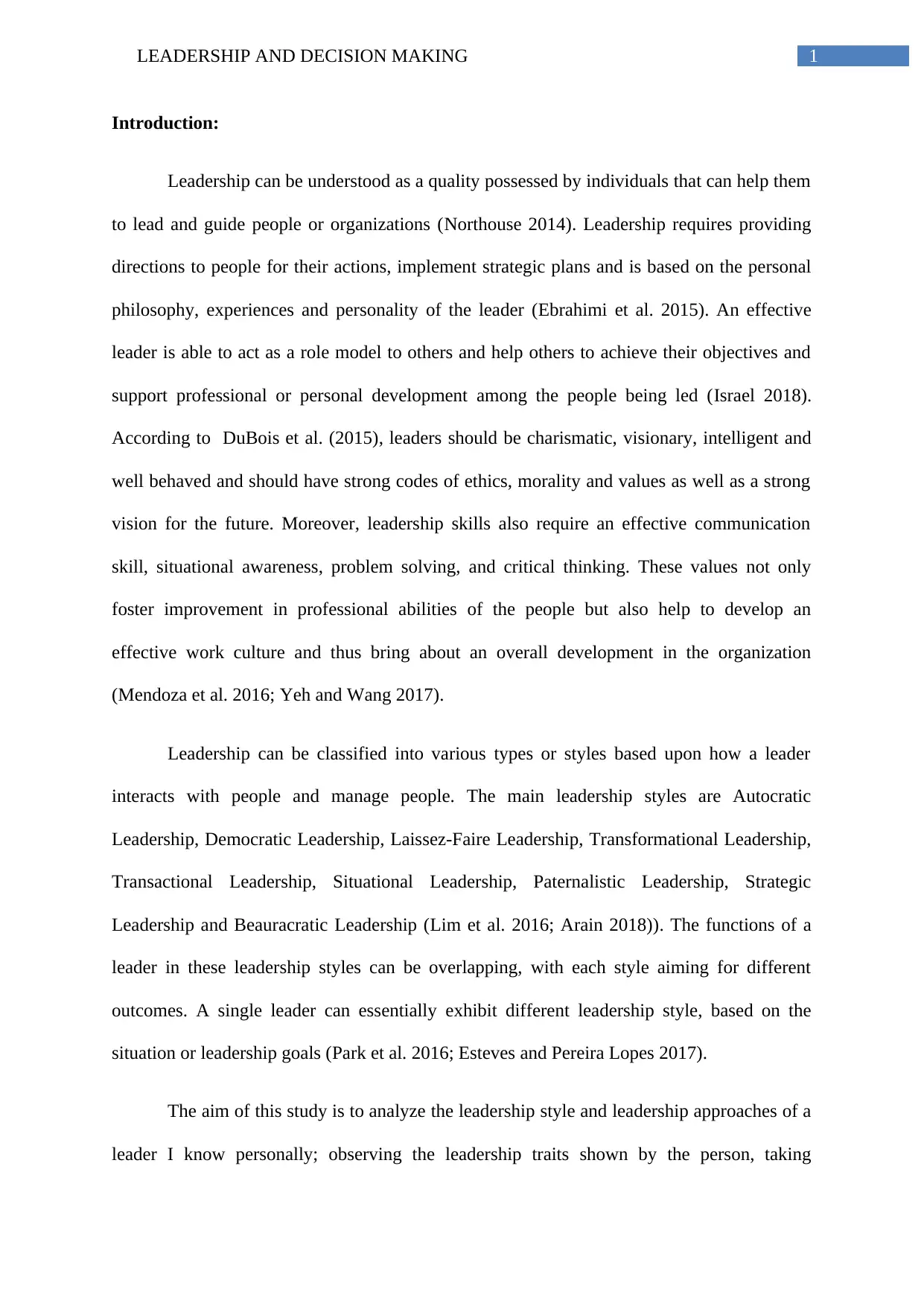
1LEADERSHIP AND DECISION MAKING
Introduction:
Leadership can be understood as a quality possessed by individuals that can help them
to lead and guide people or organizations (Northouse 2014). Leadership requires providing
directions to people for their actions, implement strategic plans and is based on the personal
philosophy, experiences and personality of the leader (Ebrahimi et al. 2015). An effective
leader is able to act as a role model to others and help others to achieve their objectives and
support professional or personal development among the people being led (Israel 2018).
According to DuBois et al. (2015), leaders should be charismatic, visionary, intelligent and
well behaved and should have strong codes of ethics, morality and values as well as a strong
vision for the future. Moreover, leadership skills also require an effective communication
skill, situational awareness, problem solving, and critical thinking. These values not only
foster improvement in professional abilities of the people but also help to develop an
effective work culture and thus bring about an overall development in the organization
(Mendoza et al. 2016; Yeh and Wang 2017).
Leadership can be classified into various types or styles based upon how a leader
interacts with people and manage people. The main leadership styles are Autocratic
Leadership, Democratic Leadership, Laissez-Faire Leadership, Transformational Leadership,
Transactional Leadership, Situational Leadership, Paternalistic Leadership, Strategic
Leadership and Beauracratic Leadership (Lim et al. 2016; Arain 2018)). The functions of a
leader in these leadership styles can be overlapping, with each style aiming for different
outcomes. A single leader can essentially exhibit different leadership style, based on the
situation or leadership goals (Park et al. 2016; Esteves and Pereira Lopes 2017).
The aim of this study is to analyze the leadership style and leadership approaches of a
leader I know personally; observing the leadership traits shown by the person, taking
Introduction:
Leadership can be understood as a quality possessed by individuals that can help them
to lead and guide people or organizations (Northouse 2014). Leadership requires providing
directions to people for their actions, implement strategic plans and is based on the personal
philosophy, experiences and personality of the leader (Ebrahimi et al. 2015). An effective
leader is able to act as a role model to others and help others to achieve their objectives and
support professional or personal development among the people being led (Israel 2018).
According to DuBois et al. (2015), leaders should be charismatic, visionary, intelligent and
well behaved and should have strong codes of ethics, morality and values as well as a strong
vision for the future. Moreover, leadership skills also require an effective communication
skill, situational awareness, problem solving, and critical thinking. These values not only
foster improvement in professional abilities of the people but also help to develop an
effective work culture and thus bring about an overall development in the organization
(Mendoza et al. 2016; Yeh and Wang 2017).
Leadership can be classified into various types or styles based upon how a leader
interacts with people and manage people. The main leadership styles are Autocratic
Leadership, Democratic Leadership, Laissez-Faire Leadership, Transformational Leadership,
Transactional Leadership, Situational Leadership, Paternalistic Leadership, Strategic
Leadership and Beauracratic Leadership (Lim et al. 2016; Arain 2018)). The functions of a
leader in these leadership styles can be overlapping, with each style aiming for different
outcomes. A single leader can essentially exhibit different leadership style, based on the
situation or leadership goals (Park et al. 2016; Esteves and Pereira Lopes 2017).
The aim of this study is to analyze the leadership style and leadership approaches of a
leader I know personally; observing the leadership traits shown by the person, taking

2LEADERSHIP AND DECISION MAKING
feedback from the person in order to learn from his/her experiences and relate those traits to
relevant theories on leadership. Through such understanding, the study aims to develop and
map an understanding on my personal professional journey to a leadership role and thus
attain professional as well as personal growth.
Discussion:
-Observation
In my personal experience, one of the strongest and most visionary leaders that I had
the privilege to work with was the Vice President of the organization I worked with. Mr.
Sebastian Harris started working in the organization with a small job role of an office clerk
and moved up the hierarchy though his hard effort and professional competency. I believe
that Mr. Harris possesses several important leadership qualities and traits that have enabled
him to become an effective organizational leader and guide the organization towards
significant success and growth as well as helping the employees to achieve their professional
goals and objectives and success. Mr. Harris is a highly driven individual, very motivated,
inspiring, intuitive, honest, hard working, intelligent, intellectual, patient, mature, empathetic,
charismatic, enthusiastic, self-assured, and confident and a visionary person. He also a very
determined person with very strong ethical and moral codes and manages the organization
ethically and respectfully, which are important traits according to Baker et al. (2017).
Moreover, he is also a very kindhearted and honest person that has helped him to gain trust
and respect from all his employees and management. Such strong traits have helped the
organization achieve significant success over the years, with the productivity of the company
nearly doubling since he was promoted to the position of Vice President and the organization
have achieved a high employee retention rates. The skilled and experienced employees
respect Mr. Harris and his contribution towards their professional success and on several
feedback from the person in order to learn from his/her experiences and relate those traits to
relevant theories on leadership. Through such understanding, the study aims to develop and
map an understanding on my personal professional journey to a leadership role and thus
attain professional as well as personal growth.
Discussion:
-Observation
In my personal experience, one of the strongest and most visionary leaders that I had
the privilege to work with was the Vice President of the organization I worked with. Mr.
Sebastian Harris started working in the organization with a small job role of an office clerk
and moved up the hierarchy though his hard effort and professional competency. I believe
that Mr. Harris possesses several important leadership qualities and traits that have enabled
him to become an effective organizational leader and guide the organization towards
significant success and growth as well as helping the employees to achieve their professional
goals and objectives and success. Mr. Harris is a highly driven individual, very motivated,
inspiring, intuitive, honest, hard working, intelligent, intellectual, patient, mature, empathetic,
charismatic, enthusiastic, self-assured, and confident and a visionary person. He also a very
determined person with very strong ethical and moral codes and manages the organization
ethically and respectfully, which are important traits according to Baker et al. (2017).
Moreover, he is also a very kindhearted and honest person that has helped him to gain trust
and respect from all his employees and management. Such strong traits have helped the
organization achieve significant success over the years, with the productivity of the company
nearly doubling since he was promoted to the position of Vice President and the organization
have achieved a high employee retention rates. The skilled and experienced employees
respect Mr. Harris and his contribution towards their professional success and on several
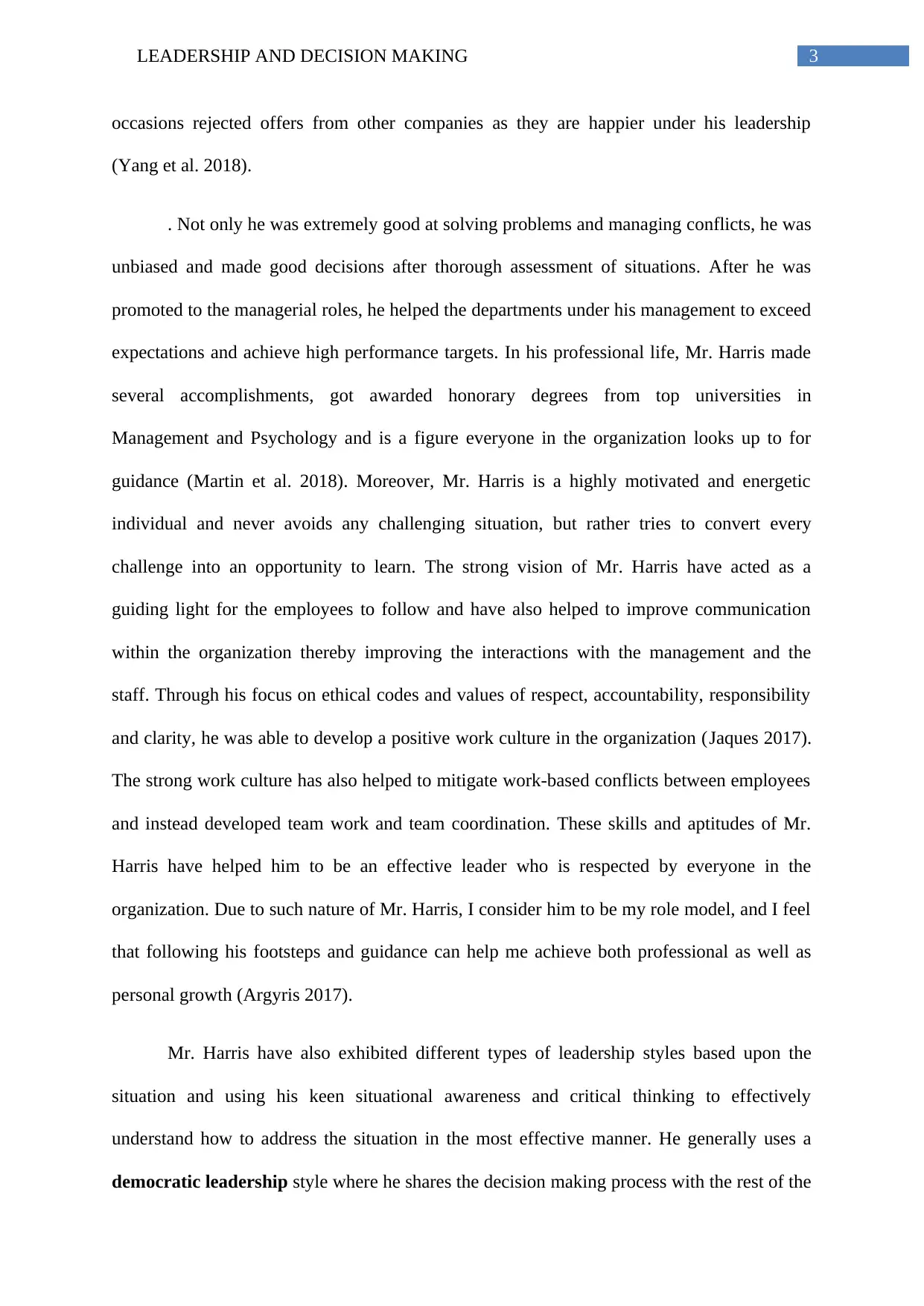
3LEADERSHIP AND DECISION MAKING
occasions rejected offers from other companies as they are happier under his leadership
(Yang et al. 2018).
. Not only he was extremely good at solving problems and managing conflicts, he was
unbiased and made good decisions after thorough assessment of situations. After he was
promoted to the managerial roles, he helped the departments under his management to exceed
expectations and achieve high performance targets. In his professional life, Mr. Harris made
several accomplishments, got awarded honorary degrees from top universities in
Management and Psychology and is a figure everyone in the organization looks up to for
guidance (Martin et al. 2018). Moreover, Mr. Harris is a highly motivated and energetic
individual and never avoids any challenging situation, but rather tries to convert every
challenge into an opportunity to learn. The strong vision of Mr. Harris have acted as a
guiding light for the employees to follow and have also helped to improve communication
within the organization thereby improving the interactions with the management and the
staff. Through his focus on ethical codes and values of respect, accountability, responsibility
and clarity, he was able to develop a positive work culture in the organization (Jaques 2017).
The strong work culture has also helped to mitigate work-based conflicts between employees
and instead developed team work and team coordination. These skills and aptitudes of Mr.
Harris have helped him to be an effective leader who is respected by everyone in the
organization. Due to such nature of Mr. Harris, I consider him to be my role model, and I feel
that following his footsteps and guidance can help me achieve both professional as well as
personal growth (Argyris 2017).
Mr. Harris have also exhibited different types of leadership styles based upon the
situation and using his keen situational awareness and critical thinking to effectively
understand how to address the situation in the most effective manner. He generally uses a
democratic leadership style where he shares the decision making process with the rest of the
occasions rejected offers from other companies as they are happier under his leadership
(Yang et al. 2018).
. Not only he was extremely good at solving problems and managing conflicts, he was
unbiased and made good decisions after thorough assessment of situations. After he was
promoted to the managerial roles, he helped the departments under his management to exceed
expectations and achieve high performance targets. In his professional life, Mr. Harris made
several accomplishments, got awarded honorary degrees from top universities in
Management and Psychology and is a figure everyone in the organization looks up to for
guidance (Martin et al. 2018). Moreover, Mr. Harris is a highly motivated and energetic
individual and never avoids any challenging situation, but rather tries to convert every
challenge into an opportunity to learn. The strong vision of Mr. Harris have acted as a
guiding light for the employees to follow and have also helped to improve communication
within the organization thereby improving the interactions with the management and the
staff. Through his focus on ethical codes and values of respect, accountability, responsibility
and clarity, he was able to develop a positive work culture in the organization (Jaques 2017).
The strong work culture has also helped to mitigate work-based conflicts between employees
and instead developed team work and team coordination. These skills and aptitudes of Mr.
Harris have helped him to be an effective leader who is respected by everyone in the
organization. Due to such nature of Mr. Harris, I consider him to be my role model, and I feel
that following his footsteps and guidance can help me achieve both professional as well as
personal growth (Argyris 2017).
Mr. Harris have also exhibited different types of leadership styles based upon the
situation and using his keen situational awareness and critical thinking to effectively
understand how to address the situation in the most effective manner. He generally uses a
democratic leadership style where he shares the decision making process with the rest of the
Paraphrase This Document
Need a fresh take? Get an instant paraphrase of this document with our AI Paraphraser
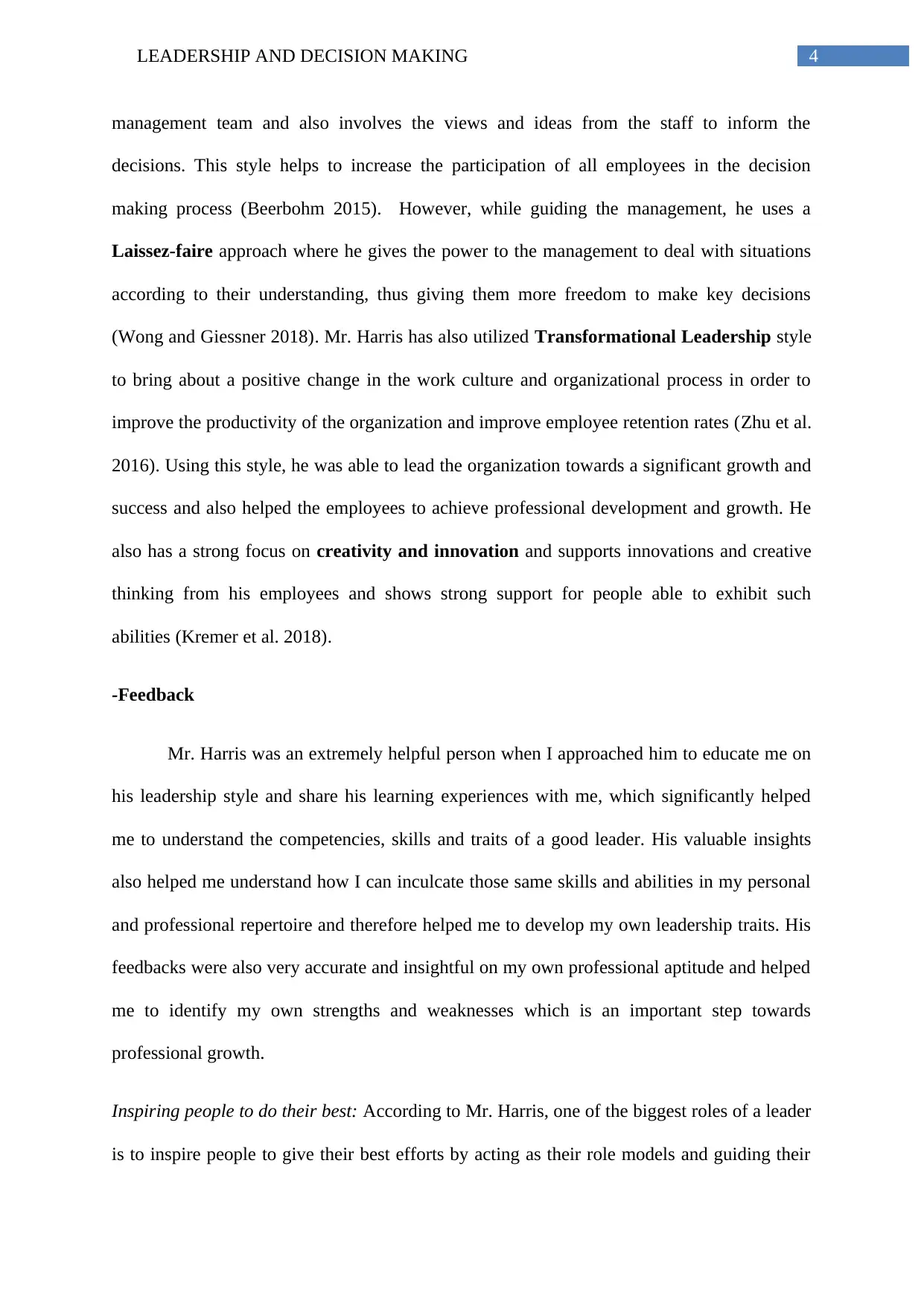
4LEADERSHIP AND DECISION MAKING
management team and also involves the views and ideas from the staff to inform the
decisions. This style helps to increase the participation of all employees in the decision
making process (Beerbohm 2015). However, while guiding the management, he uses a
Laissez-faire approach where he gives the power to the management to deal with situations
according to their understanding, thus giving them more freedom to make key decisions
(Wong and Giessner 2018). Mr. Harris has also utilized Transformational Leadership style
to bring about a positive change in the work culture and organizational process in order to
improve the productivity of the organization and improve employee retention rates (Zhu et al.
2016). Using this style, he was able to lead the organization towards a significant growth and
success and also helped the employees to achieve professional development and growth. He
also has a strong focus on creativity and innovation and supports innovations and creative
thinking from his employees and shows strong support for people able to exhibit such
abilities (Kremer et al. 2018).
-Feedback
Mr. Harris was an extremely helpful person when I approached him to educate me on
his leadership style and share his learning experiences with me, which significantly helped
me to understand the competencies, skills and traits of a good leader. His valuable insights
also helped me understand how I can inculcate those same skills and abilities in my personal
and professional repertoire and therefore helped me to develop my own leadership traits. His
feedbacks were also very accurate and insightful on my own professional aptitude and helped
me to identify my own strengths and weaknesses which is an important step towards
professional growth.
Inspiring people to do their best: According to Mr. Harris, one of the biggest roles of a leader
is to inspire people to give their best efforts by acting as their role models and guiding their
management team and also involves the views and ideas from the staff to inform the
decisions. This style helps to increase the participation of all employees in the decision
making process (Beerbohm 2015). However, while guiding the management, he uses a
Laissez-faire approach where he gives the power to the management to deal with situations
according to their understanding, thus giving them more freedom to make key decisions
(Wong and Giessner 2018). Mr. Harris has also utilized Transformational Leadership style
to bring about a positive change in the work culture and organizational process in order to
improve the productivity of the organization and improve employee retention rates (Zhu et al.
2016). Using this style, he was able to lead the organization towards a significant growth and
success and also helped the employees to achieve professional development and growth. He
also has a strong focus on creativity and innovation and supports innovations and creative
thinking from his employees and shows strong support for people able to exhibit such
abilities (Kremer et al. 2018).
-Feedback
Mr. Harris was an extremely helpful person when I approached him to educate me on
his leadership style and share his learning experiences with me, which significantly helped
me to understand the competencies, skills and traits of a good leader. His valuable insights
also helped me understand how I can inculcate those same skills and abilities in my personal
and professional repertoire and therefore helped me to develop my own leadership traits. His
feedbacks were also very accurate and insightful on my own professional aptitude and helped
me to identify my own strengths and weaknesses which is an important step towards
professional growth.
Inspiring people to do their best: According to Mr. Harris, one of the biggest roles of a leader
is to inspire people to give their best efforts by acting as their role models and guiding their
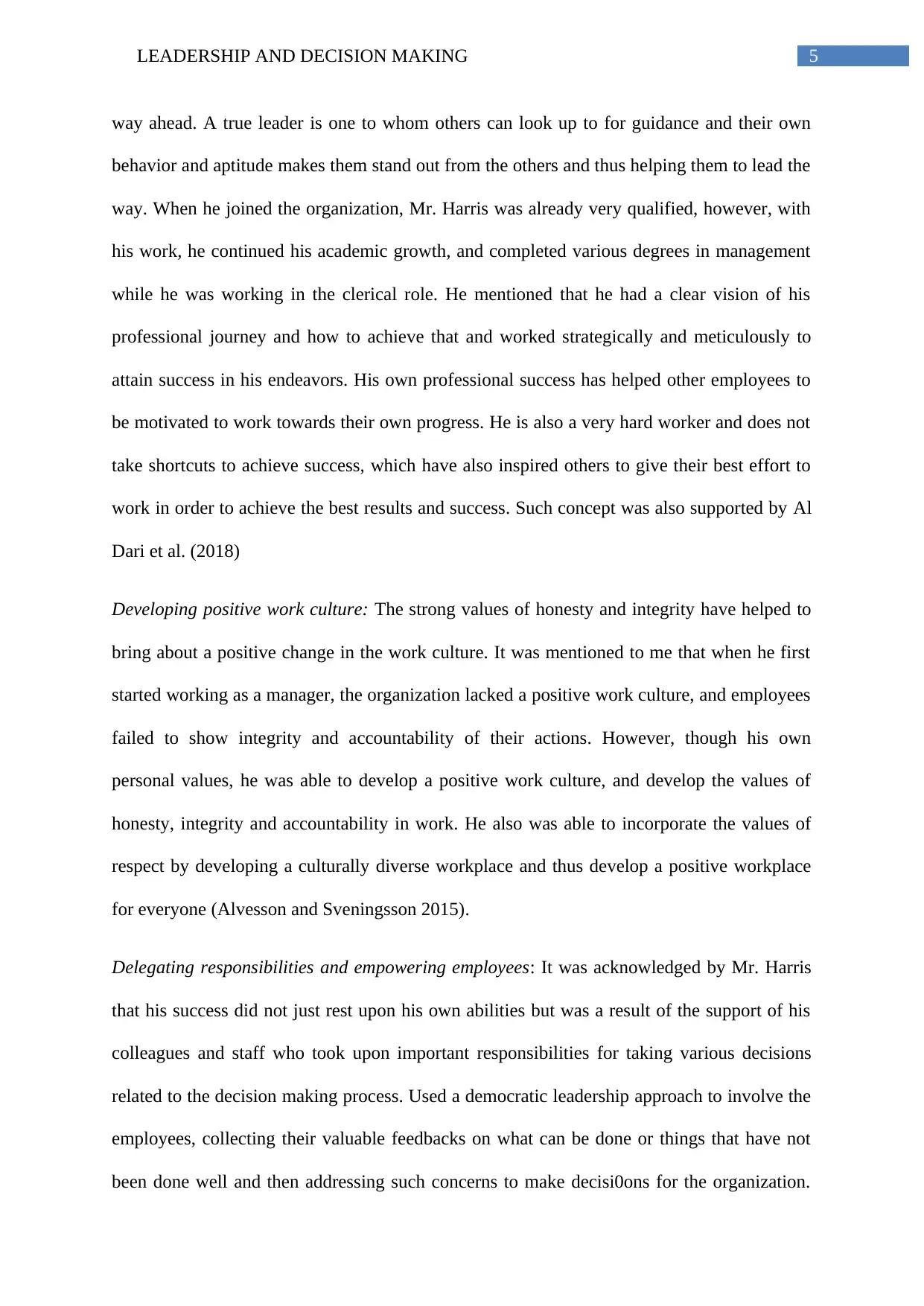
5LEADERSHIP AND DECISION MAKING
way ahead. A true leader is one to whom others can look up to for guidance and their own
behavior and aptitude makes them stand out from the others and thus helping them to lead the
way. When he joined the organization, Mr. Harris was already very qualified, however, with
his work, he continued his academic growth, and completed various degrees in management
while he was working in the clerical role. He mentioned that he had a clear vision of his
professional journey and how to achieve that and worked strategically and meticulously to
attain success in his endeavors. His own professional success has helped other employees to
be motivated to work towards their own progress. He is also a very hard worker and does not
take shortcuts to achieve success, which have also inspired others to give their best effort to
work in order to achieve the best results and success. Such concept was also supported by Al
Dari et al. (2018)
Developing positive work culture: The strong values of honesty and integrity have helped to
bring about a positive change in the work culture. It was mentioned to me that when he first
started working as a manager, the organization lacked a positive work culture, and employees
failed to show integrity and accountability of their actions. However, though his own
personal values, he was able to develop a positive work culture, and develop the values of
honesty, integrity and accountability in work. He also was able to incorporate the values of
respect by developing a culturally diverse workplace and thus develop a positive workplace
for everyone (Alvesson and Sveningsson 2015).
Delegating responsibilities and empowering employees: It was acknowledged by Mr. Harris
that his success did not just rest upon his own abilities but was a result of the support of his
colleagues and staff who took upon important responsibilities for taking various decisions
related to the decision making process. Used a democratic leadership approach to involve the
employees, collecting their valuable feedbacks on what can be done or things that have not
been done well and then addressing such concerns to make decisi0ons for the organization.
way ahead. A true leader is one to whom others can look up to for guidance and their own
behavior and aptitude makes them stand out from the others and thus helping them to lead the
way. When he joined the organization, Mr. Harris was already very qualified, however, with
his work, he continued his academic growth, and completed various degrees in management
while he was working in the clerical role. He mentioned that he had a clear vision of his
professional journey and how to achieve that and worked strategically and meticulously to
attain success in his endeavors. His own professional success has helped other employees to
be motivated to work towards their own progress. He is also a very hard worker and does not
take shortcuts to achieve success, which have also inspired others to give their best effort to
work in order to achieve the best results and success. Such concept was also supported by Al
Dari et al. (2018)
Developing positive work culture: The strong values of honesty and integrity have helped to
bring about a positive change in the work culture. It was mentioned to me that when he first
started working as a manager, the organization lacked a positive work culture, and employees
failed to show integrity and accountability of their actions. However, though his own
personal values, he was able to develop a positive work culture, and develop the values of
honesty, integrity and accountability in work. He also was able to incorporate the values of
respect by developing a culturally diverse workplace and thus develop a positive workplace
for everyone (Alvesson and Sveningsson 2015).
Delegating responsibilities and empowering employees: It was acknowledged by Mr. Harris
that his success did not just rest upon his own abilities but was a result of the support of his
colleagues and staff who took upon important responsibilities for taking various decisions
related to the decision making process. Used a democratic leadership approach to involve the
employees, collecting their valuable feedbacks on what can be done or things that have not
been done well and then addressing such concerns to make decisi0ons for the organization.

6LEADERSHIP AND DECISION MAKING
He also mentioned that he also gave freedom to management employees to exercise their
skills and decision making process to take decisions independently. However, it was also
informed that such a process was not very easy, as it resulted in wrong decisions being taken
at times which later had to be revoked, but still provided an important learning opportunity
for the management and thus helped to develop their competency (Zhu et al. 2016).
Encouraging productivity through rewards and recognition: Mr. Harris mentioned that he
noticed that the employees were not properly motivated and encouraged through effective
reward and recognition program and so after he was promoted to upper management, he
incorporated strong programs to give rewards and recognitions to employees for productivity,
code of conduct, support as well as for their own professional development. This helped to
develop a healthy competition among the employees and thus helped not only to improve the
productivity of the organization, but also helped to develop and maintain a strong working
culture within the organization (Wong and Giessner 2018).
Showing empathy towards others: Empathy was an important trait as per the opinion of Mr.
Harris. According to him, it is vital to see the human side of things and not just the
professional one, as different employees might come across different challenging situations
that can affect their ability to work. Showing empathy while working with employees not
only helps to gain their trust but also understand their perspective and understand how they
can be managed or overcome. While trying to increase the productivity of the organization,
Mr. Harris had to take individual meeting with every employee, which was time consuming
process, but provided him with valuable insight on how to improve and support better
productivity from them. He also involved them to develop personalized professional growth
plans for each employee that can help them to increase their skills and competencies. He also
implemented training [programs for employees in need of help (Martin et al. 2018).
He also mentioned that he also gave freedom to management employees to exercise their
skills and decision making process to take decisions independently. However, it was also
informed that such a process was not very easy, as it resulted in wrong decisions being taken
at times which later had to be revoked, but still provided an important learning opportunity
for the management and thus helped to develop their competency (Zhu et al. 2016).
Encouraging productivity through rewards and recognition: Mr. Harris mentioned that he
noticed that the employees were not properly motivated and encouraged through effective
reward and recognition program and so after he was promoted to upper management, he
incorporated strong programs to give rewards and recognitions to employees for productivity,
code of conduct, support as well as for their own professional development. This helped to
develop a healthy competition among the employees and thus helped not only to improve the
productivity of the organization, but also helped to develop and maintain a strong working
culture within the organization (Wong and Giessner 2018).
Showing empathy towards others: Empathy was an important trait as per the opinion of Mr.
Harris. According to him, it is vital to see the human side of things and not just the
professional one, as different employees might come across different challenging situations
that can affect their ability to work. Showing empathy while working with employees not
only helps to gain their trust but also understand their perspective and understand how they
can be managed or overcome. While trying to increase the productivity of the organization,
Mr. Harris had to take individual meeting with every employee, which was time consuming
process, but provided him with valuable insight on how to improve and support better
productivity from them. He also involved them to develop personalized professional growth
plans for each employee that can help them to increase their skills and competencies. He also
implemented training [programs for employees in need of help (Martin et al. 2018).
Secure Best Marks with AI Grader
Need help grading? Try our AI Grader for instant feedback on your assignments.
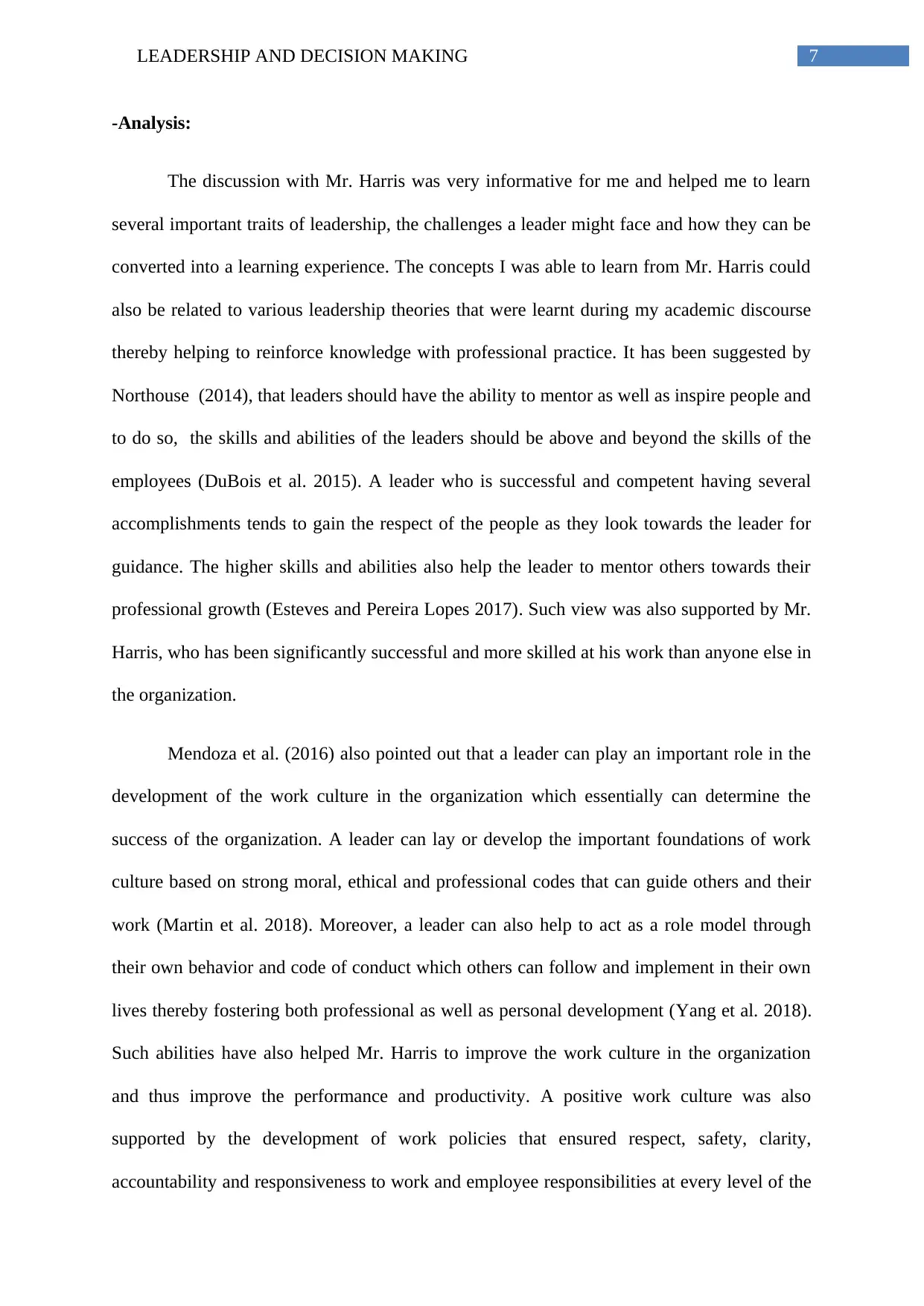
7LEADERSHIP AND DECISION MAKING
-Analysis:
The discussion with Mr. Harris was very informative for me and helped me to learn
several important traits of leadership, the challenges a leader might face and how they can be
converted into a learning experience. The concepts I was able to learn from Mr. Harris could
also be related to various leadership theories that were learnt during my academic discourse
thereby helping to reinforce knowledge with professional practice. It has been suggested by
Northouse (2014), that leaders should have the ability to mentor as well as inspire people and
to do so, the skills and abilities of the leaders should be above and beyond the skills of the
employees (DuBois et al. 2015). A leader who is successful and competent having several
accomplishments tends to gain the respect of the people as they look towards the leader for
guidance. The higher skills and abilities also help the leader to mentor others towards their
professional growth (Esteves and Pereira Lopes 2017). Such view was also supported by Mr.
Harris, who has been significantly successful and more skilled at his work than anyone else in
the organization.
Mendoza et al. (2016) also pointed out that a leader can play an important role in the
development of the work culture in the organization which essentially can determine the
success of the organization. A leader can lay or develop the important foundations of work
culture based on strong moral, ethical and professional codes that can guide others and their
work (Martin et al. 2018). Moreover, a leader can also help to act as a role model through
their own behavior and code of conduct which others can follow and implement in their own
lives thereby fostering both professional as well as personal development (Yang et al. 2018).
Such abilities have also helped Mr. Harris to improve the work culture in the organization
and thus improve the performance and productivity. A positive work culture was also
supported by the development of work policies that ensured respect, safety, clarity,
accountability and responsiveness to work and employee responsibilities at every level of the
-Analysis:
The discussion with Mr. Harris was very informative for me and helped me to learn
several important traits of leadership, the challenges a leader might face and how they can be
converted into a learning experience. The concepts I was able to learn from Mr. Harris could
also be related to various leadership theories that were learnt during my academic discourse
thereby helping to reinforce knowledge with professional practice. It has been suggested by
Northouse (2014), that leaders should have the ability to mentor as well as inspire people and
to do so, the skills and abilities of the leaders should be above and beyond the skills of the
employees (DuBois et al. 2015). A leader who is successful and competent having several
accomplishments tends to gain the respect of the people as they look towards the leader for
guidance. The higher skills and abilities also help the leader to mentor others towards their
professional growth (Esteves and Pereira Lopes 2017). Such view was also supported by Mr.
Harris, who has been significantly successful and more skilled at his work than anyone else in
the organization.
Mendoza et al. (2016) also pointed out that a leader can play an important role in the
development of the work culture in the organization which essentially can determine the
success of the organization. A leader can lay or develop the important foundations of work
culture based on strong moral, ethical and professional codes that can guide others and their
work (Martin et al. 2018). Moreover, a leader can also help to act as a role model through
their own behavior and code of conduct which others can follow and implement in their own
lives thereby fostering both professional as well as personal development (Yang et al. 2018).
Such abilities have also helped Mr. Harris to improve the work culture in the organization
and thus improve the performance and productivity. A positive work culture was also
supported by the development of work policies that ensured respect, safety, clarity,
accountability and responsiveness to work and employee responsibilities at every level of the
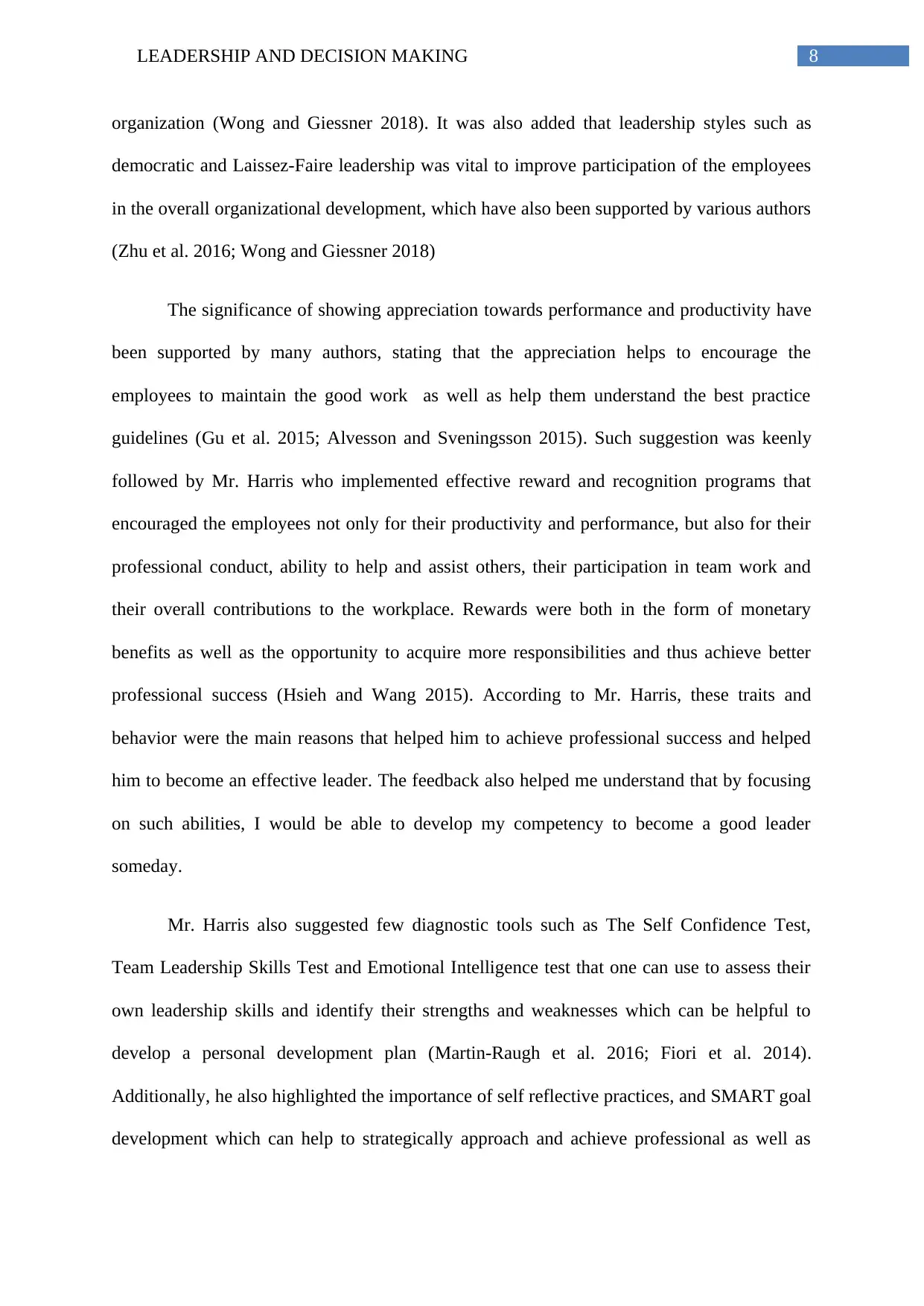
8LEADERSHIP AND DECISION MAKING
organization (Wong and Giessner 2018). It was also added that leadership styles such as
democratic and Laissez-Faire leadership was vital to improve participation of the employees
in the overall organizational development, which have also been supported by various authors
(Zhu et al. 2016; Wong and Giessner 2018)
The significance of showing appreciation towards performance and productivity have
been supported by many authors, stating that the appreciation helps to encourage the
employees to maintain the good work as well as help them understand the best practice
guidelines (Gu et al. 2015; Alvesson and Sveningsson 2015). Such suggestion was keenly
followed by Mr. Harris who implemented effective reward and recognition programs that
encouraged the employees not only for their productivity and performance, but also for their
professional conduct, ability to help and assist others, their participation in team work and
their overall contributions to the workplace. Rewards were both in the form of monetary
benefits as well as the opportunity to acquire more responsibilities and thus achieve better
professional success (Hsieh and Wang 2015). According to Mr. Harris, these traits and
behavior were the main reasons that helped him to achieve professional success and helped
him to become an effective leader. The feedback also helped me understand that by focusing
on such abilities, I would be able to develop my competency to become a good leader
someday.
Mr. Harris also suggested few diagnostic tools such as The Self Confidence Test,
Team Leadership Skills Test and Emotional Intelligence test that one can use to assess their
own leadership skills and identify their strengths and weaknesses which can be helpful to
develop a personal development plan (Martin-Raugh et al. 2016; Fiori et al. 2014).
Additionally, he also highlighted the importance of self reflective practices, and SMART goal
development which can help to strategically approach and achieve professional as well as
organization (Wong and Giessner 2018). It was also added that leadership styles such as
democratic and Laissez-Faire leadership was vital to improve participation of the employees
in the overall organizational development, which have also been supported by various authors
(Zhu et al. 2016; Wong and Giessner 2018)
The significance of showing appreciation towards performance and productivity have
been supported by many authors, stating that the appreciation helps to encourage the
employees to maintain the good work as well as help them understand the best practice
guidelines (Gu et al. 2015; Alvesson and Sveningsson 2015). Such suggestion was keenly
followed by Mr. Harris who implemented effective reward and recognition programs that
encouraged the employees not only for their productivity and performance, but also for their
professional conduct, ability to help and assist others, their participation in team work and
their overall contributions to the workplace. Rewards were both in the form of monetary
benefits as well as the opportunity to acquire more responsibilities and thus achieve better
professional success (Hsieh and Wang 2015). According to Mr. Harris, these traits and
behavior were the main reasons that helped him to achieve professional success and helped
him to become an effective leader. The feedback also helped me understand that by focusing
on such abilities, I would be able to develop my competency to become a good leader
someday.
Mr. Harris also suggested few diagnostic tools such as The Self Confidence Test,
Team Leadership Skills Test and Emotional Intelligence test that one can use to assess their
own leadership skills and identify their strengths and weaknesses which can be helpful to
develop a personal development plan (Martin-Raugh et al. 2016; Fiori et al. 2014).
Additionally, he also highlighted the importance of self reflective practices, and SMART goal
development which can help to strategically approach and achieve professional as well as
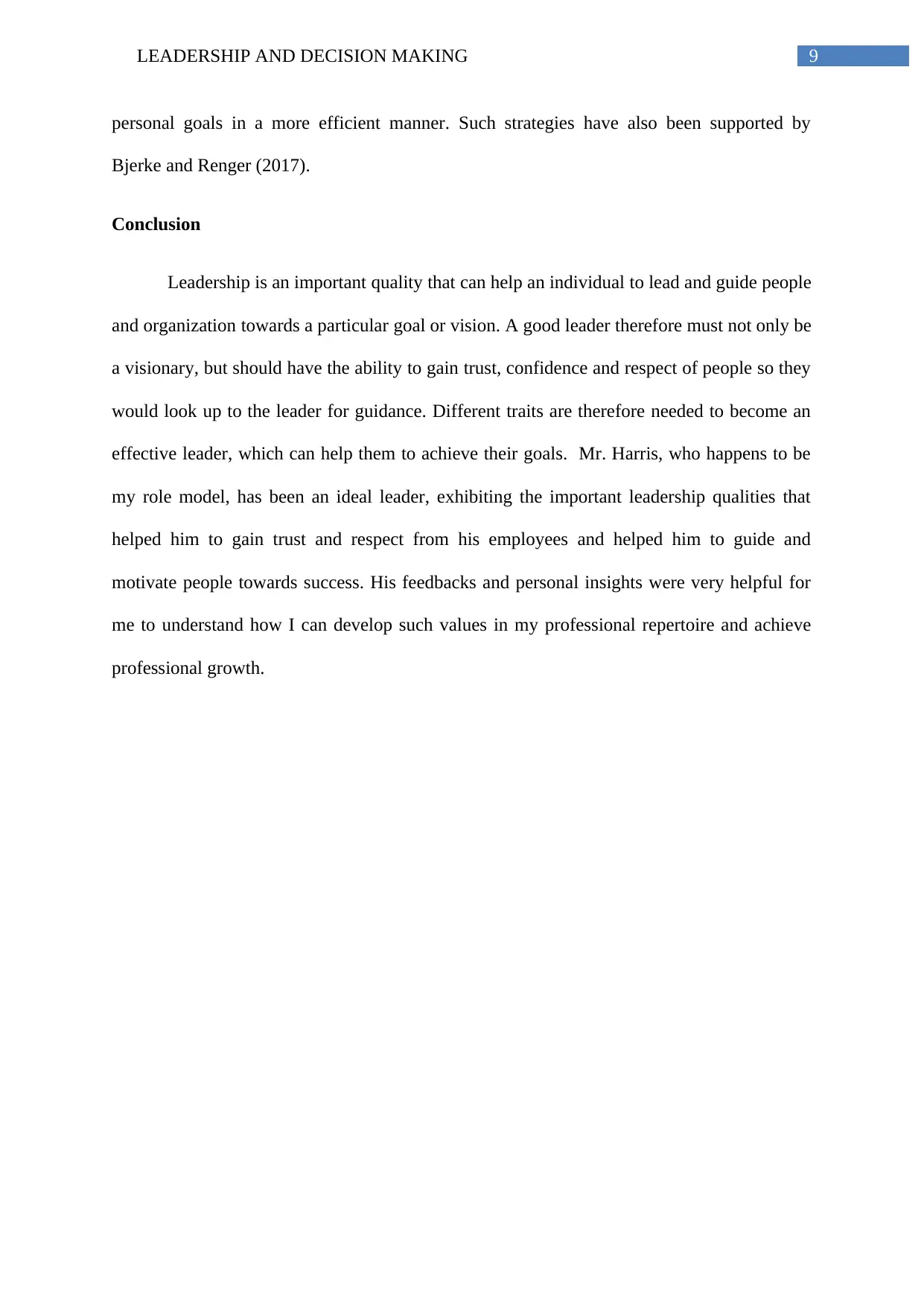
9LEADERSHIP AND DECISION MAKING
personal goals in a more efficient manner. Such strategies have also been supported by
Bjerke and Renger (2017).
Conclusion
Leadership is an important quality that can help an individual to lead and guide people
and organization towards a particular goal or vision. A good leader therefore must not only be
a visionary, but should have the ability to gain trust, confidence and respect of people so they
would look up to the leader for guidance. Different traits are therefore needed to become an
effective leader, which can help them to achieve their goals. Mr. Harris, who happens to be
my role model, has been an ideal leader, exhibiting the important leadership qualities that
helped him to gain trust and respect from his employees and helped him to guide and
motivate people towards success. His feedbacks and personal insights were very helpful for
me to understand how I can develop such values in my professional repertoire and achieve
professional growth.
personal goals in a more efficient manner. Such strategies have also been supported by
Bjerke and Renger (2017).
Conclusion
Leadership is an important quality that can help an individual to lead and guide people
and organization towards a particular goal or vision. A good leader therefore must not only be
a visionary, but should have the ability to gain trust, confidence and respect of people so they
would look up to the leader for guidance. Different traits are therefore needed to become an
effective leader, which can help them to achieve their goals. Mr. Harris, who happens to be
my role model, has been an ideal leader, exhibiting the important leadership qualities that
helped him to gain trust and respect from his employees and helped him to guide and
motivate people towards success. His feedbacks and personal insights were very helpful for
me to understand how I can develop such values in my professional repertoire and achieve
professional growth.
Paraphrase This Document
Need a fresh take? Get an instant paraphrase of this document with our AI Paraphraser
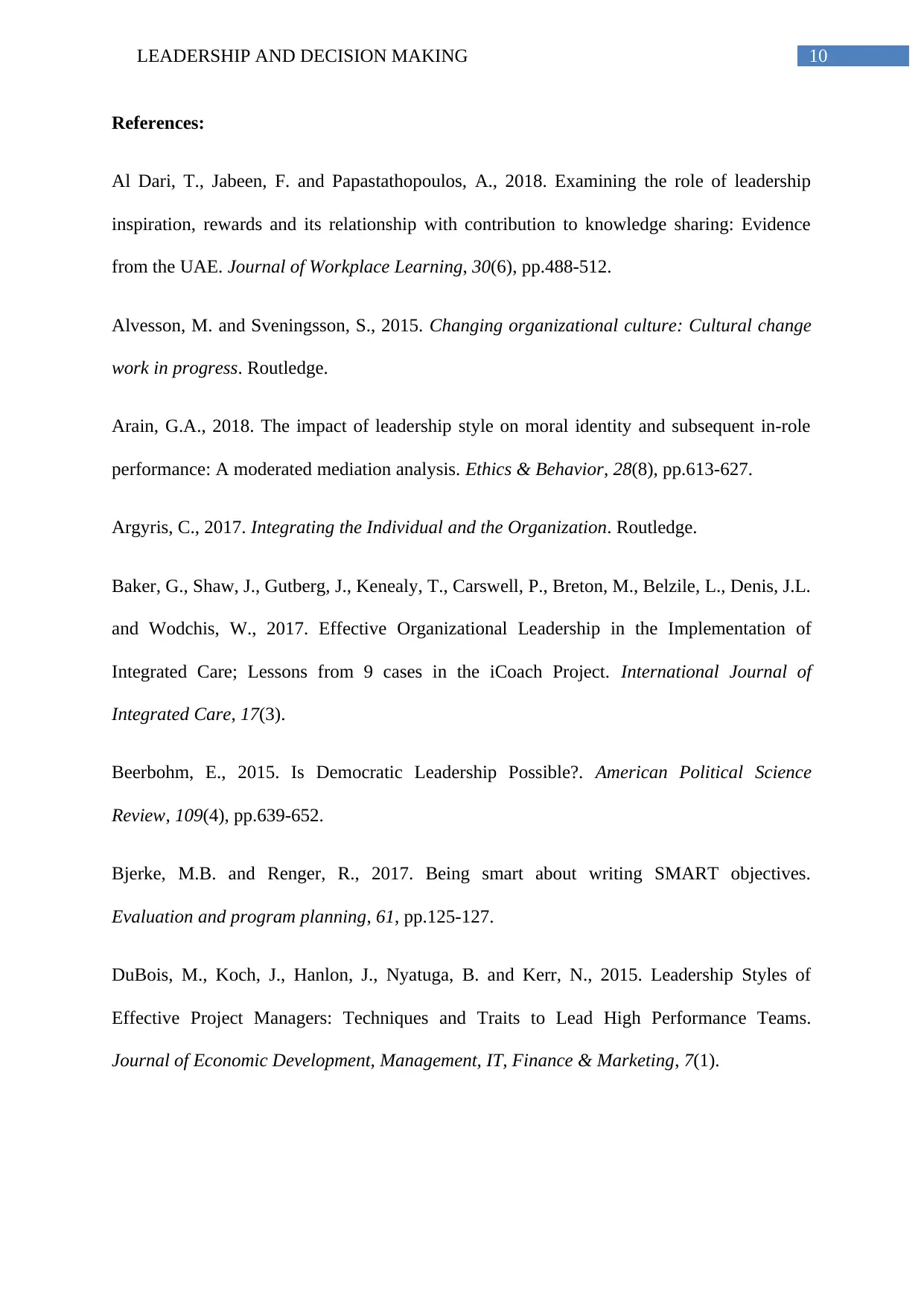
10LEADERSHIP AND DECISION MAKING
References:
Al Dari, T., Jabeen, F. and Papastathopoulos, A., 2018. Examining the role of leadership
inspiration, rewards and its relationship with contribution to knowledge sharing: Evidence
from the UAE. Journal of Workplace Learning, 30(6), pp.488-512.
Alvesson, M. and Sveningsson, S., 2015. Changing organizational culture: Cultural change
work in progress. Routledge.
Arain, G.A., 2018. The impact of leadership style on moral identity and subsequent in-role
performance: A moderated mediation analysis. Ethics & Behavior, 28(8), pp.613-627.
Argyris, C., 2017. Integrating the Individual and the Organization. Routledge.
Baker, G., Shaw, J., Gutberg, J., Kenealy, T., Carswell, P., Breton, M., Belzile, L., Denis, J.L.
and Wodchis, W., 2017. Effective Organizational Leadership in the Implementation of
Integrated Care; Lessons from 9 cases in the iCoach Project. International Journal of
Integrated Care, 17(3).
Beerbohm, E., 2015. Is Democratic Leadership Possible?. American Political Science
Review, 109(4), pp.639-652.
Bjerke, M.B. and Renger, R., 2017. Being smart about writing SMART objectives.
Evaluation and program planning, 61, pp.125-127.
DuBois, M., Koch, J., Hanlon, J., Nyatuga, B. and Kerr, N., 2015. Leadership Styles of
Effective Project Managers: Techniques and Traits to Lead High Performance Teams.
Journal of Economic Development, Management, IT, Finance & Marketing, 7(1).
References:
Al Dari, T., Jabeen, F. and Papastathopoulos, A., 2018. Examining the role of leadership
inspiration, rewards and its relationship with contribution to knowledge sharing: Evidence
from the UAE. Journal of Workplace Learning, 30(6), pp.488-512.
Alvesson, M. and Sveningsson, S., 2015. Changing organizational culture: Cultural change
work in progress. Routledge.
Arain, G.A., 2018. The impact of leadership style on moral identity and subsequent in-role
performance: A moderated mediation analysis. Ethics & Behavior, 28(8), pp.613-627.
Argyris, C., 2017. Integrating the Individual and the Organization. Routledge.
Baker, G., Shaw, J., Gutberg, J., Kenealy, T., Carswell, P., Breton, M., Belzile, L., Denis, J.L.
and Wodchis, W., 2017. Effective Organizational Leadership in the Implementation of
Integrated Care; Lessons from 9 cases in the iCoach Project. International Journal of
Integrated Care, 17(3).
Beerbohm, E., 2015. Is Democratic Leadership Possible?. American Political Science
Review, 109(4), pp.639-652.
Bjerke, M.B. and Renger, R., 2017. Being smart about writing SMART objectives.
Evaluation and program planning, 61, pp.125-127.
DuBois, M., Koch, J., Hanlon, J., Nyatuga, B. and Kerr, N., 2015. Leadership Styles of
Effective Project Managers: Techniques and Traits to Lead High Performance Teams.
Journal of Economic Development, Management, IT, Finance & Marketing, 7(1).
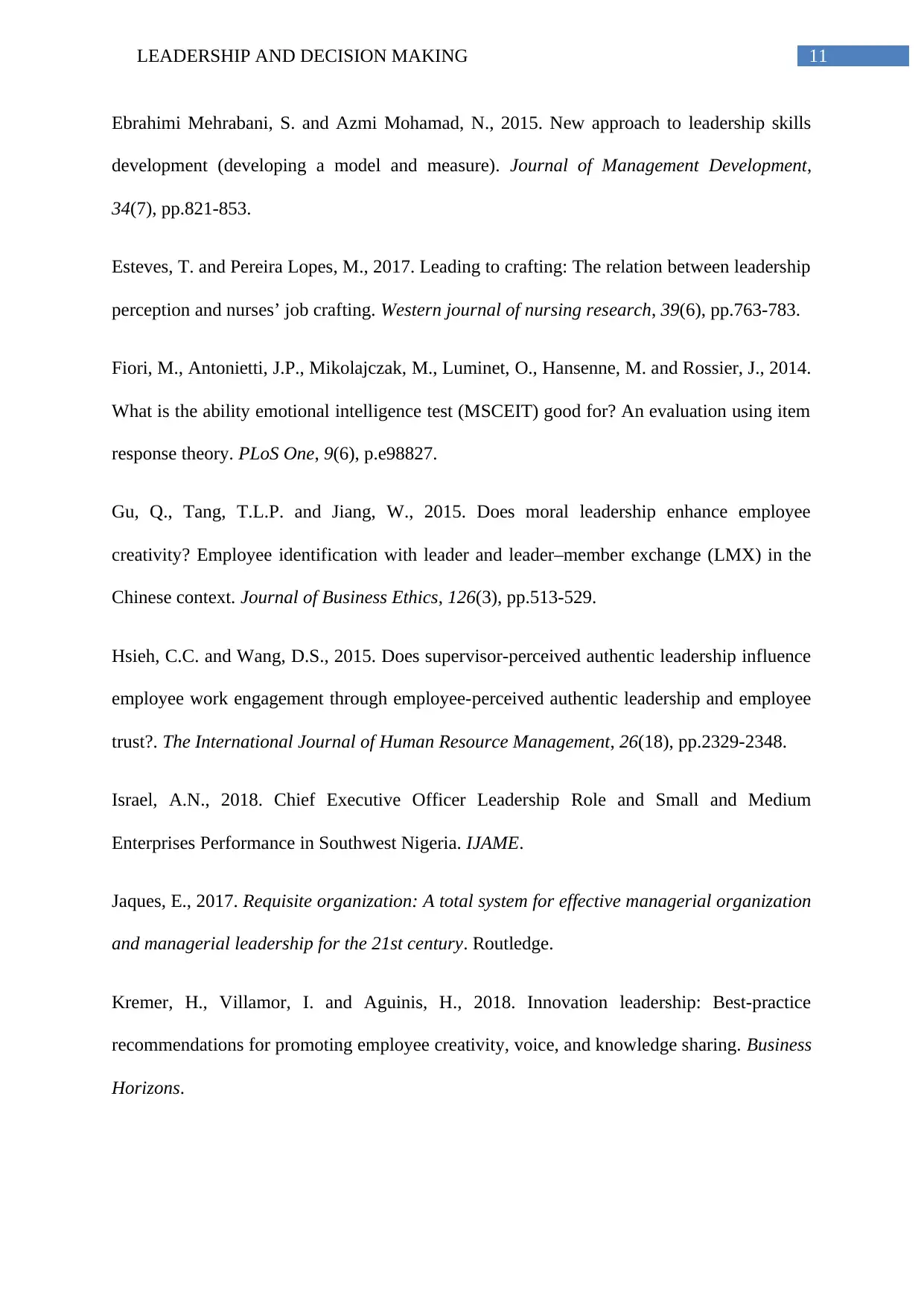
11LEADERSHIP AND DECISION MAKING
Ebrahimi Mehrabani, S. and Azmi Mohamad, N., 2015. New approach to leadership skills
development (developing a model and measure). Journal of Management Development,
34(7), pp.821-853.
Esteves, T. and Pereira Lopes, M., 2017. Leading to crafting: The relation between leadership
perception and nurses’ job crafting. Western journal of nursing research, 39(6), pp.763-783.
Fiori, M., Antonietti, J.P., Mikolajczak, M., Luminet, O., Hansenne, M. and Rossier, J., 2014.
What is the ability emotional intelligence test (MSCEIT) good for? An evaluation using item
response theory. PLoS One, 9(6), p.e98827.
Gu, Q., Tang, T.L.P. and Jiang, W., 2015. Does moral leadership enhance employee
creativity? Employee identification with leader and leader–member exchange (LMX) in the
Chinese context. Journal of Business Ethics, 126(3), pp.513-529.
Hsieh, C.C. and Wang, D.S., 2015. Does supervisor-perceived authentic leadership influence
employee work engagement through employee-perceived authentic leadership and employee
trust?. The International Journal of Human Resource Management, 26(18), pp.2329-2348.
Israel, A.N., 2018. Chief Executive Officer Leadership Role and Small and Medium
Enterprises Performance in Southwest Nigeria. IJAME.
Jaques, E., 2017. Requisite organization: A total system for effective managerial organization
and managerial leadership for the 21st century. Routledge.
Kremer, H., Villamor, I. and Aguinis, H., 2018. Innovation leadership: Best-practice
recommendations for promoting employee creativity, voice, and knowledge sharing. Business
Horizons.
Ebrahimi Mehrabani, S. and Azmi Mohamad, N., 2015. New approach to leadership skills
development (developing a model and measure). Journal of Management Development,
34(7), pp.821-853.
Esteves, T. and Pereira Lopes, M., 2017. Leading to crafting: The relation between leadership
perception and nurses’ job crafting. Western journal of nursing research, 39(6), pp.763-783.
Fiori, M., Antonietti, J.P., Mikolajczak, M., Luminet, O., Hansenne, M. and Rossier, J., 2014.
What is the ability emotional intelligence test (MSCEIT) good for? An evaluation using item
response theory. PLoS One, 9(6), p.e98827.
Gu, Q., Tang, T.L.P. and Jiang, W., 2015. Does moral leadership enhance employee
creativity? Employee identification with leader and leader–member exchange (LMX) in the
Chinese context. Journal of Business Ethics, 126(3), pp.513-529.
Hsieh, C.C. and Wang, D.S., 2015. Does supervisor-perceived authentic leadership influence
employee work engagement through employee-perceived authentic leadership and employee
trust?. The International Journal of Human Resource Management, 26(18), pp.2329-2348.
Israel, A.N., 2018. Chief Executive Officer Leadership Role and Small and Medium
Enterprises Performance in Southwest Nigeria. IJAME.
Jaques, E., 2017. Requisite organization: A total system for effective managerial organization
and managerial leadership for the 21st century. Routledge.
Kremer, H., Villamor, I. and Aguinis, H., 2018. Innovation leadership: Best-practice
recommendations for promoting employee creativity, voice, and knowledge sharing. Business
Horizons.
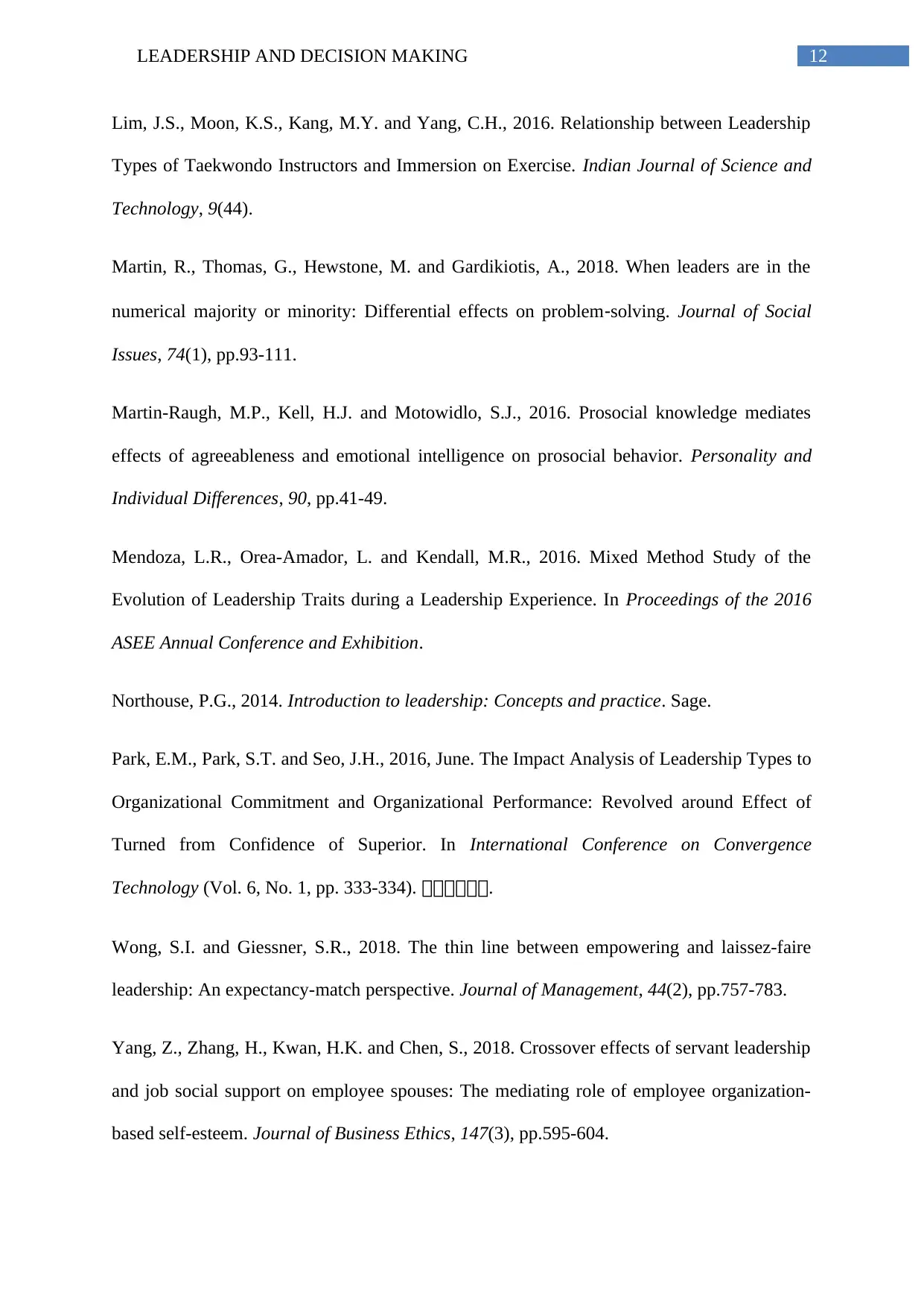
12LEADERSHIP AND DECISION MAKING
Lim, J.S., Moon, K.S., Kang, M.Y. and Yang, C.H., 2016. Relationship between Leadership
Types of Taekwondo Instructors and Immersion on Exercise. Indian Journal of Science and
Technology, 9(44).
Martin, R., Thomas, G., Hewstone, M. and Gardikiotis, A., 2018. When leaders are in the
numerical majority or minority: Differential effects on problem‐solving. Journal of Social
Issues, 74(1), pp.93-111.
Martin-Raugh, M.P., Kell, H.J. and Motowidlo, S.J., 2016. Prosocial knowledge mediates
effects of agreeableness and emotional intelligence on prosocial behavior. Personality and
Individual Differences, 90, pp.41-49.
Mendoza, L.R., Orea-Amador, L. and Kendall, M.R., 2016. Mixed Method Study of the
Evolution of Leadership Traits during a Leadership Experience. In Proceedings of the 2016
ASEE Annual Conference and Exhibition.
Northouse, P.G., 2014. Introduction to leadership: Concepts and practice. Sage.
Park, E.M., Park, S.T. and Seo, J.H., 2016, June. The Impact Analysis of Leadership Types to
Organizational Commitment and Organizational Performance: Revolved around Effect of
Turned from Confidence of Superior. In International Conference on Convergence
Technology (Vol. 6, No. 1, pp. 333-334). 한한한한한한.
Wong, S.I. and Giessner, S.R., 2018. The thin line between empowering and laissez-faire
leadership: An expectancy-match perspective. Journal of Management, 44(2), pp.757-783.
Yang, Z., Zhang, H., Kwan, H.K. and Chen, S., 2018. Crossover effects of servant leadership
and job social support on employee spouses: The mediating role of employee organization-
based self-esteem. Journal of Business Ethics, 147(3), pp.595-604.
Lim, J.S., Moon, K.S., Kang, M.Y. and Yang, C.H., 2016. Relationship between Leadership
Types of Taekwondo Instructors and Immersion on Exercise. Indian Journal of Science and
Technology, 9(44).
Martin, R., Thomas, G., Hewstone, M. and Gardikiotis, A., 2018. When leaders are in the
numerical majority or minority: Differential effects on problem‐solving. Journal of Social
Issues, 74(1), pp.93-111.
Martin-Raugh, M.P., Kell, H.J. and Motowidlo, S.J., 2016. Prosocial knowledge mediates
effects of agreeableness and emotional intelligence on prosocial behavior. Personality and
Individual Differences, 90, pp.41-49.
Mendoza, L.R., Orea-Amador, L. and Kendall, M.R., 2016. Mixed Method Study of the
Evolution of Leadership Traits during a Leadership Experience. In Proceedings of the 2016
ASEE Annual Conference and Exhibition.
Northouse, P.G., 2014. Introduction to leadership: Concepts and practice. Sage.
Park, E.M., Park, S.T. and Seo, J.H., 2016, June. The Impact Analysis of Leadership Types to
Organizational Commitment and Organizational Performance: Revolved around Effect of
Turned from Confidence of Superior. In International Conference on Convergence
Technology (Vol. 6, No. 1, pp. 333-334). 한한한한한한.
Wong, S.I. and Giessner, S.R., 2018. The thin line between empowering and laissez-faire
leadership: An expectancy-match perspective. Journal of Management, 44(2), pp.757-783.
Yang, Z., Zhang, H., Kwan, H.K. and Chen, S., 2018. Crossover effects of servant leadership
and job social support on employee spouses: The mediating role of employee organization-
based self-esteem. Journal of Business Ethics, 147(3), pp.595-604.
Secure Best Marks with AI Grader
Need help grading? Try our AI Grader for instant feedback on your assignments.
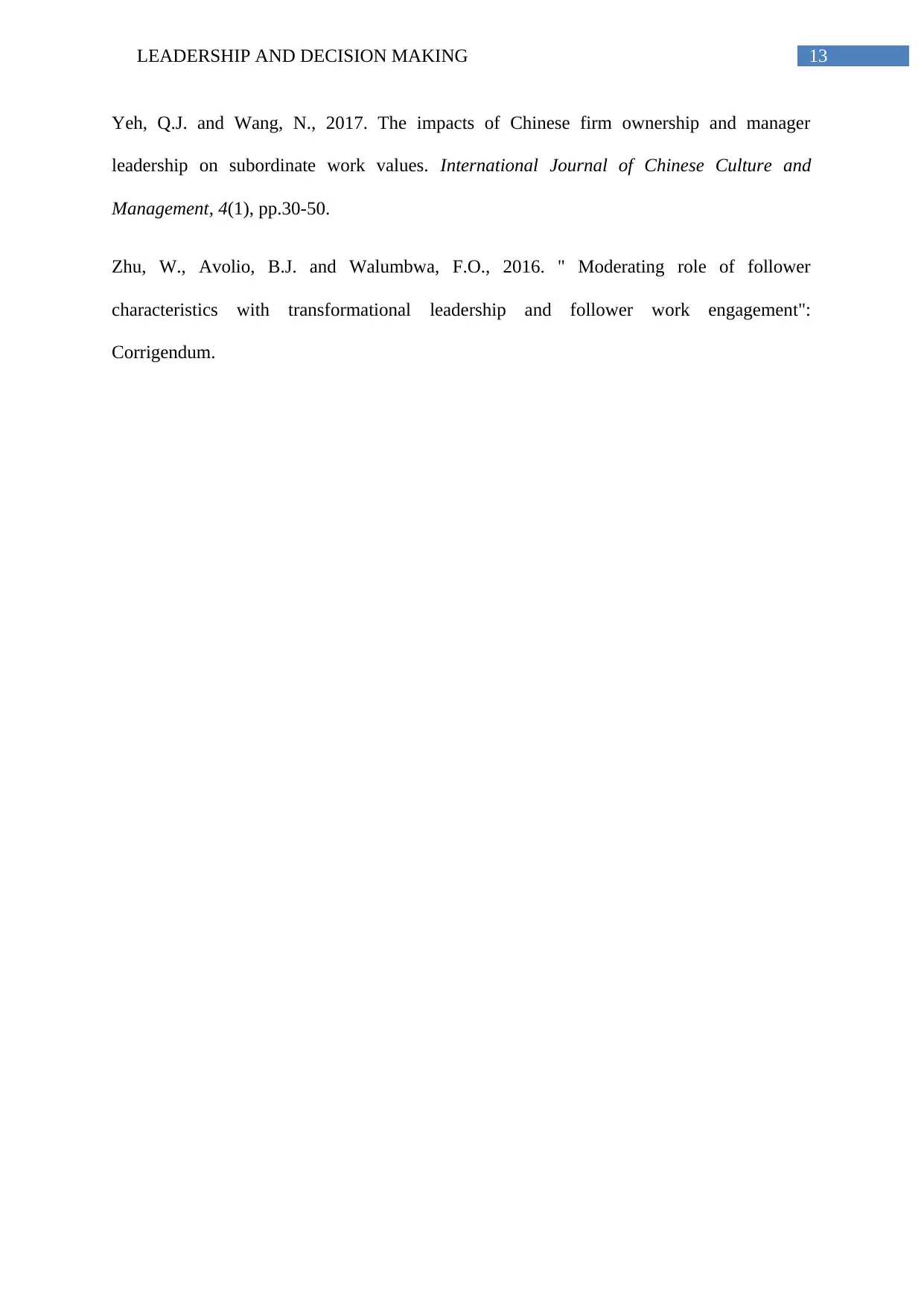
13LEADERSHIP AND DECISION MAKING
Yeh, Q.J. and Wang, N., 2017. The impacts of Chinese firm ownership and manager
leadership on subordinate work values. International Journal of Chinese Culture and
Management, 4(1), pp.30-50.
Zhu, W., Avolio, B.J. and Walumbwa, F.O., 2016. " Moderating role of follower
characteristics with transformational leadership and follower work engagement":
Corrigendum.
Yeh, Q.J. and Wang, N., 2017. The impacts of Chinese firm ownership and manager
leadership on subordinate work values. International Journal of Chinese Culture and
Management, 4(1), pp.30-50.
Zhu, W., Avolio, B.J. and Walumbwa, F.O., 2016. " Moderating role of follower
characteristics with transformational leadership and follower work engagement":
Corrigendum.
1 out of 14
![[object Object]](/_next/static/media/star-bottom.7253800d.svg)




